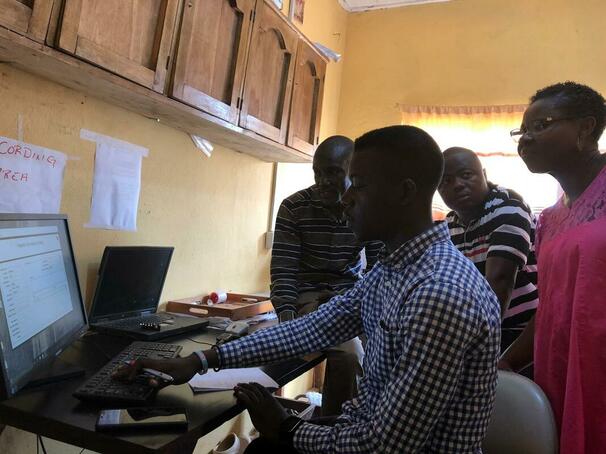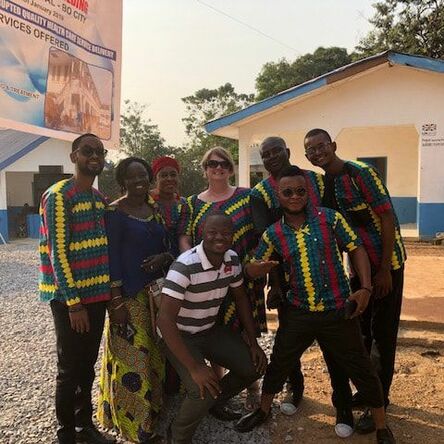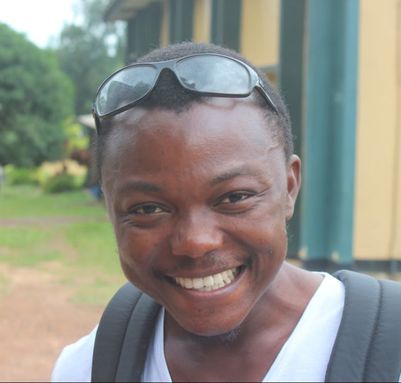 Ishmael Vandi (front), Joseph Lamin (left), Jinnah Lahai, and Cynthia Grant Ishmael Vandi (front), Joseph Lamin (left), Jinnah Lahai, and Cynthia Grant On Friday, January 18, Mercy Hospital officially launched its Electronic Medical Information System (EMIS) - a database which will enable the hospital to use electronic medical records to track patient data. The first electronic records management system in the country, the database will have a positive impact on patient care as it will be much easier to access a patient's history and chart. Hospital Administrator, Jinnah Lahai, is thrilled about this new addition to Mercy. “It has added more value to Mercy in comparison to other facilities. It will lead to greater transparency and data security." Joseph Lamin and the Mercy Laboratory team, has led the effort in creating the software that will be used. District Medical Officer, Dr. Roland Carshon-Marsh, is working closely with Mercy to supervise compliance with standards for medical records management and confidentiality. While paper will no longer be used for data entry, communication, or analysis, every electronic medical records system maintains redundant electronic and paper record back up copies - and Mercy's EMIS is no exception. Once the electronic information system is fully operational, all units of the hospital will contribute to it, enabling all patient information to be stored electronically. The EMIS also tracks drug and supply inventory and staff shift time logs. EMIS produces valid research data on diagnosis as well as effective interventions and treatments. Under the current system, patients are tracked by a patient number, but if they forget or lose that number, the staff is forced to either sort through thousands of patient cards or start a new chart. Starting a new chart is easier, but it means the loss of all patient history that preceded it. The new system will make communication between units instantaneous which will mean that patients are able to receive input on their care from a variety of Mercy staff in real time. Registration of patients will include fingerprint identification as an element to permit accurately matching patient charts with medical histories. Sierra Leone has a high rate of illiteracy and poor records in villages. Patients often do not know how to spell their names or have current address information or know their date of birth. Paper records often become damaged and unreadable or lost. Fingerprint identification mitigates against all of these challenges. Creating reports based on the data will be much easier and more accurate. The database will greatly reduce the chances of error and leave more time for analyzing data and refining programs instead of painstakingly gathering numbers. Data will also be collected from the outreach programs, which will help Mercy identify trends in who is seeking care at Mercy or its outreach, what are the most concerning diseases, and how programs can be altered to best suit the needs of the community. Lamin projects that the Mercy staff will be comfortable using the system within two weeks of its mid-January launch, and adept by week six. Mercy Dr. Sao Amara, is looking forward to the system becoming fully operational, “it will help with tracking patients, increase financial accountability, reduce patient wait times, assure patient confidentiality and and allow staff to be informed about patient status quickly.”
0 Comments
 On Friday, January 18, Mercy Hospital officially opened the doors of its long-awaited Surgical Wing. The celebration included remarks from various dignitaries and Mercy leadership, a welcome song performed by Mercy staff, the Act of Dedication performed by Bishop Yambasu, an official ribbon-cutting and tour of the new surgical wing, and refreshments. Bishop John K. Yambasu, District Medical Officer Dr. Roland Carshon-Marsh, UMC Health Coordinator Catherine Norman, UMC Bo District Superintendent Reverend Francis Charley, Chairman of the UMC Health Board Dr. Dennis Marke, and HCW Executive Director Melody Curtiss each shared remarks at the ceremony. Reverend Charley opened the ceremony with prayer, stating that “this hospital is a state of the art hospital and is going to provide facilities and treatment for patients in the country and even beyond.” Bishop Yambasu shared that this day is the result of “the passion, dedication and commitment of our friends from the United States. Helping Children Worldwide has been involved in our work with the Child Rescue Centre and Mercy Hospital for more than 20 years.” Catherine Norman reflected on Mercy's history, saying “almost 13 years ago, a one-room health clinic with two health staff was established to provide first aid, nutrition and basic health care to the children of the CRC. In 2007, the building in front of us was transformed into Mercy Hospital. I am glad that today, the dream of a functional surgical building has come true. With this building, Mercy Hospital has now been empowered to provide quality care not only to the Bo, but the entire district, and even beyond.” The Bishop performed the official Act of Dedication, asking God to “graciously accept this building which we now dedicate to thee, to thy service, and to thy glory, that in it skill and tenderness may unite to bring health and cure to those who come for aid…. Grant that those who come here in weakness may be made strong, that those who come in pain may find relief, and that those who come in sorrow may find joy and gladness.” On behalf of HCW, Mrs. Curtiss recognized the contributions of all of its donors, particularly the large bequests of Ebenezer United Methodist Church in Stafford, VA, without whose generosity the wing would not have been built, and the Peterson Family Foundation, who sponsored the shipment of surgical supplies and equipment necessary for an operating theatre. Mrs. Curtiss also recognized the special contributions of Mercy Laboratory Technician, Joseph Lamin, who is heading up the launch of Mercy Hospital’s new Electronic Medical Information System (see story at bottom of newsletter). Mercy’s surgical wing includes two operating theatres, a recovery room, decontamination room, sterilzation room, male and female changing rooms, medical supplies storage, reception and doctors’ consultation rooms. Second floor includes a private and semi-private wards, male and female wards, conference room and ICU. Mercy’s surgical program will operate on a limited capacity, as they await the arrival of a blood bank. Until this important piece of equipment arrives, Mercy will continue to provide the surgeries that it always has, now in a new, state-of-the-art surgical facility. Dr. Amara continues to work with Dr. Boima (a COMAHS professor and surgeon) to assist in surgeries beyond his current level of expertise, and now that those surgeries can be performed at Mercy, other staff will benefit in training opportunities as well. Qualified surgeons who wish to perform surgeries at Mercy with Dr. Amara’s assistance, will be welcomed for the purpose of providing Mercy staff with teaching opportunities. This will include medical teams from overseas from time to time. Nonprofits utilizing Mercy OR for their own medical missions will do trainings as part of the privilege of performing surgeries at Mercy, and leave behind unused equipment and supplies for future use by Mercy. Project CURE is scheduled to provide training in obstetrics and critical care to Mercy staff this year, and Dr. Amara and Matron August Kpanebaum will be attending GBGM training in obstetrics and Cesarean-sections in February-March.  Henry Kebbie works at the Child Rescue Centre (CRC) as the Assistant Coordinator for the Sponsor A Child Program. Henry is also responsible for a caseload of 70 children supported by the CRC’s programs. Engaged to be married soon, Henry is the proud papa of a young daughter. Henry’s story is unique in that he was a child supported by the CRC’s Child Support Program, which provided health and education support from primary through secondary school. After graduation, he applied for and won a Promise Scholarship which enabled him to attend university. Graduating with honors, Henry holds a Bachelor of Science in Social Work from Njala University. Henry credits his being a CRC student with his path toward becoming a social worker. “It has always been my desire to be a social worker so that I could return to work with an organization like the CRC which is working to save helpless families and especially destitute children,” Henry says. Henry applies the lessons he’s learned to his work with the children on his caseload. “I always encourage them to take their studies very seriously, as I did,” he says. “I went through the same program at the CRC, and now I am working for the CRC. I believe it is important that children are educated and grow up to be a good example for others, just like I am.” Henry Kebbie was drawn to social work out of a desire to help people - particularly those who are vulnerable. At the Child Rescue Centre (CRC), Henry found an opportunity to help the most vulnerable children and their families. He was deeply interested in community development and wanted to engage in work that would have a deep, lasting and positive impact. Being a case manager for vulnerable children and their families helps him see that impact every day. Henry finds the work at CRC particularly rewarding because of the CRC’s vision and focus to give something positive to the community of Bo. Henry’s deepest hopes for the children on his caseload are that they all do well in school and find a bright future, and that they all know how deeply they are blessed by God. |
Follow us on social media
Archive
July 2024
Click the button to read heartfelt tributes to a beloved Bishop, co- founder of our mission!
Post
|
Helping Children Worldwide is a 501 (c) 3 nonprofit organization | 703-793-9521 | [email protected]
©2017 - 2021 Helping Children Worldwide
All donations in the United States are tax-deductible in full or part. | Donor and Privacy Policy
©2017 - 2021 Helping Children Worldwide
All donations in the United States are tax-deductible in full or part. | Donor and Privacy Policy






